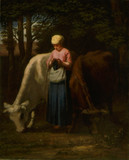William Morris Hunt was the earliest and foremost proponent of Barbizon art in America and a popular portrait painter and teacher in Boston. Born into a well-to-do family, Hunt attended Harvard University, but his poor health prompted his family to move to Italy, where Hunt studied sculpture with Henry Kirke Brown (1814-1886). In 1845 he enrolled in the Düsseldorf Academy on the advice of EMANUEL LEUTZE. Dissatisfied with the strict training, he moved to Paris in 1846 and became one of the first Americans to study with Thomas Couture (1815-1879), staying in his atelier for five years. Around 1853 he began a two-year association with Jean-Franqois Millet (1814 -1875) at Barbizon. In 1852 he made his debut at the Paris Salon and in 1855 was one of the few Americans to participate in the Universal Exposition in Paris.
In 1855 he returned to New England and settled in Newport, Rhode Island, where he transferred his knowledge and admiration of French painting to a group of artists, among them JOHN LA FARGE, that congregated around him there. In the 1860s he established a studio in Boston and, with the assistance of the social connections of his wife, Louisa Dumaresq Perkins, became a much sought-after portrait painter of Boston’s upper class. He also exhibited paintings of picturesque Europeans, Barbizon-inspired pastorals, and portraits, and became active in other aspects of local art life, helping to form the Allston Club in 1866 to promote modern art. The same year he left for about a year’s stay in Europe, living in Italy and France and spending the summer painting landscapes at Dinan, France, with ELIHU VEDDER and Charles Caryl Coleman (1840-1928). During that trip he also began to work increasingly in charcoal. Upon his return home he opened his studio to female students, becoming the most influential teacher in Boston before the establishment of the School of the Museum of Fine Arts. His lectures were compiled and published by one of his students after his death as Talks on Art.
In 1873 he visited Magnolia Springs, Florida, and from that time on landscape painting became his dominant concern. The following year he traveled to Cuba and Mexico. In 1878 he was commissioned to decorate the lunettes of the New York State Capitol with allegorical murals of Anahita and Columbus. Suffering from depression, Hunt visited his writer-friend Celia Thaxter at her home on the Isle of Shoals; there he drowned, whether by suicide or accident.
BIBLIOGRAPHY
Henry C. Angell, Records of William M. Hunt (Boston: J. R. Osgood, 1881) § Helen M. Knowlton, comp., W. M. Hunt’s Talks on Art, First Series (Boston: Houghton Mifflin, [1875]); idem, W. M. Hunt’s Talks on Art, Second Series (Boston: Houghton Mifflin, 1883) § Helen M. Knowlton, Art-Life of William Morris Hunt (Boston: Little Brown, 1900) § Martha A. S. Shannon, Boston Days of William Morris Hunt (Boston: Marshall Jones, 1923) § College Park, University of Maryland Art Gallery, and Albany (N.Y.) Institute of History and Art, The Late Landscapes of William Morris Hunt, exh. cat., 1976, with introduction by Marchal E. Landgren, chronology and catalogue entries by Sharman Wallace McGurn.

